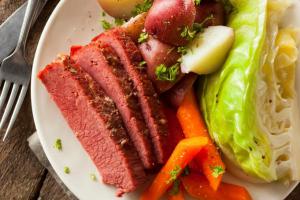Stop Foodborne Illness Shares Tips to Avoid Getting “Sham-Rocked” by Foodborne Illness This St. Patrick’s Day
Luck of the Irish only goes so far. Knowing how to store, prepare, cook and reheat your corned beef will help you avoid foodborne illness this St. Paddy's Day.
Just because your food may look done, and the meat may still look pink, this does not indicate it is done.”
CHICAGO, IL, UNITED STATES, March 4, 2019 /EINPresswire.com/ -- As St. Patrick’s Day approaches, you might be thinking of eating a home-cooked meal of corned beef and cabbage, and of course, consuming a few (or more) beers to go along with it. But, in between all the fun, how do you keep these foods safe to eat and avoid being affected and getting “sham-rocked” by foodborne illness this holiday? Stop Foodborne Illness, a national nonprofit, public health organization dedicated to preventing illness and death from foodborne pathogens, wants you to be aware of how preventing foodborne illness while you get in touch with your inner Irish this St. Patrick’s Day. — Stanley Rutledge, Stop Foodborne Illness
Keeping Corned Beef Safe to Eat – Storing and Preparing:
The luck of the Irish only goes so far, so knowing how to properly store, prepare, cook, and reheat your corned beef will help you avoid foodborne illness this St. Paddy’s Day. Corned beef comes from the tougher part of the cow, and to tenderize the beef it is placed in a bath of salt water along with spices, most commonly peppercorns and bay leaf. If you buy uncooked corned beef in a salt brine drain the brine before freezing or refrigerating because the excess salt can cause the beef to go rancid. If the brine is not drained, the corned beef can be stored unopened safely 5 to 7 days in the refrigerator.
Keeping Corned Beef Safe to Eat – Cooking and Leftovers:
Corned beef can be prepared in several different ways, and the USDA doesn’t recommend one kind of cooking over the other. The five freshest ways to fix corned beef are: 1) in the oven, 2) in an oven cooking bag, 3) in a slow cooker, 4) on the stove, and 5) in the microwave. Just make sure that you follow the temperature and time instructions for the specific cooking method that you are using. Find the USDA’s instructions for cooking corned beef here: https://www.fsis.usda.gov/wps/portal/fsis/topics/food-safety-education/get-answers/food-safety-fact-sheets/meat-preparation/corned-beef-and-food-safety/ct_index.
The USDA says that “fork-tender” (https://www.fsis.usda.gov/wps/portal/fsis/topics/food-safety-education/get-answers/food-safety-fact-sheets/meat-preparation/corned-beef-and-food-safety/ct_index) is a “good indication of doneness”, but to use a food thermometer to make sure the meat is heated to an internal temperature of at least 145 degrees Fahrenheit before consuming. In an article by Stanley Rutledge of Stop Foodborne Illness, he says that just because your food may look done, and the meat may still look pink, this does not indicate it is done. A food thermometer is essential to making sure your food is safe to eat. Take a look at this list from Stop Foodborne Illness of safe internal cooking temperatures for reference.
Also, allow the meat to rest for at least 3 minutes before carving and eating. If cooking ahead of time, allow the beef to cool, slice it, and place it in containers to refrigerate within two hours (https://stopfoodborneillness.org/wp-content/uploads/2017/10/How-Temperatures-Affect-Food-Meat-Thermometers.pdf) of cooking. Leftover corned beef can be consumed safely within 3-4 days of cooking when put in the fridge or can be frozen for up to 2-3 months. Reheat any leftovers to an internal temperature of at least 165 degrees Fahrenheit and use a food thermometer to check.
Cocktails and Eating Out:
This St. Patrick’s Day, you might also decide to indulge in a specialty traditional cocktail, like the An Bodhran, or treat yourself to a night out to eat. However, use caution when partaking in specialty drinks because some ingredients could potentially lead to foodborne illness. For example, An Bodhran, made with Irish Whiskey and maple sugar, also contains a raw egg. Stop Foodborne Illness warns against consuming raw eggs (https://stopfoodborneillness.org/fsn-eating-raw-cookie-dough-and-other-risky-mistakes/) because raw eggs could contain salmonella, a harmful bacteria that leads directly to food poisoning and foodborne illness.
Additionally, when treating yourself to a night out, if you have any suspicions about the safety of the food delivered to your table you should not hesitate to raise concerns, Stop Foodborne Illness provides some helpful tips on how to address these kinds of food safety concerns. We want you to have a safe, healthy, and delicious St. Patrick’s Day this year.
Food Safety – In General:
In general, according to the CDC, food can be contaminated when bacteria are transferred from the kitchen tools to the food, when unwashed hands are used to handle food, and when foods are not packaged correctly. Learn more about how food gets contaminated here.
Four simple ways (https://www.cdc.gov/foodsafety/keep-food-safe.html) to keep food safe, according to the CDC, are to
1) wash surfaces, hands, and fresh produce
2) keep meat, seafood, poultry, and eggs separate in food preparation and food storage
3) cook food thoroughly by using a food thermometer
4) freeze food to keep safe until you can cook it
Your kitchen and cooking equipment should be food safe, too. Stop Foodborne Illness also has tips on how to properly clean, sanitize, and disinfect your kitchen tools and home to minimize the transfer of bacteria from your kitchen area to your food. According to Stop Foodborne Illness, the first step is to clean visible crumbs and mess from your dishes and utensils. The second step is to sanitize them with high heat or chemical solution to kill harmful bacteria, and the third step is to disinfect your kitchen surfaces with a cleaning solution.
About Stop Foodborne Illness
Stop Foodborne Illness is a national nonprofit, public health organization dedicated to preventing illness and death from foodborne pathogens by promoting sound food safety policy and best practices, building public awareness, and assisting those impacted by foodborne illness. For more food safety tips please visit www.Stopfoodborneillness.org/awareness/. If you think you have been sickened from food, contact your local health professional. You may subscribe to receive Stop Foodborne Illness e-Alerts and eNews here: www.Stopfoodborneillness.org/take-action/sign-up-for-e-alerts/.
Follow Stop’s latest news at www.newsline360.com/stopfoodborneillness.
Follow Stop on Facebook at www.facebook.com/stopfoodborneillness.
Follow Stop on Twitter: www.twitter.com/StopFoodillness.
To receive our news, Follow us here: www.newsline360.com/stopfoodborneillness.
Click the Follow Us icon on upper right corner)
For questions and personal assistance, please contact Stanley Rutledge, Community Coordinator, at srutledge@Stopfoodborneillness.org or 773-269-6555 x7.
Cindy Kurman
Kurman Communications for Stop Foodborne Illness
+1 312-651-9000
email us here
Visit us on social media:
Facebook
Twitter
Google+
LinkedIn
Legal Disclaimer:
EIN Presswire provides this news content "as is" without warranty of any kind. We do not accept any responsibility or liability for the accuracy, content, images, videos, licenses, completeness, legality, or reliability of the information contained in this article. If you have any complaints or copyright issues related to this article, kindly contact the author above.




